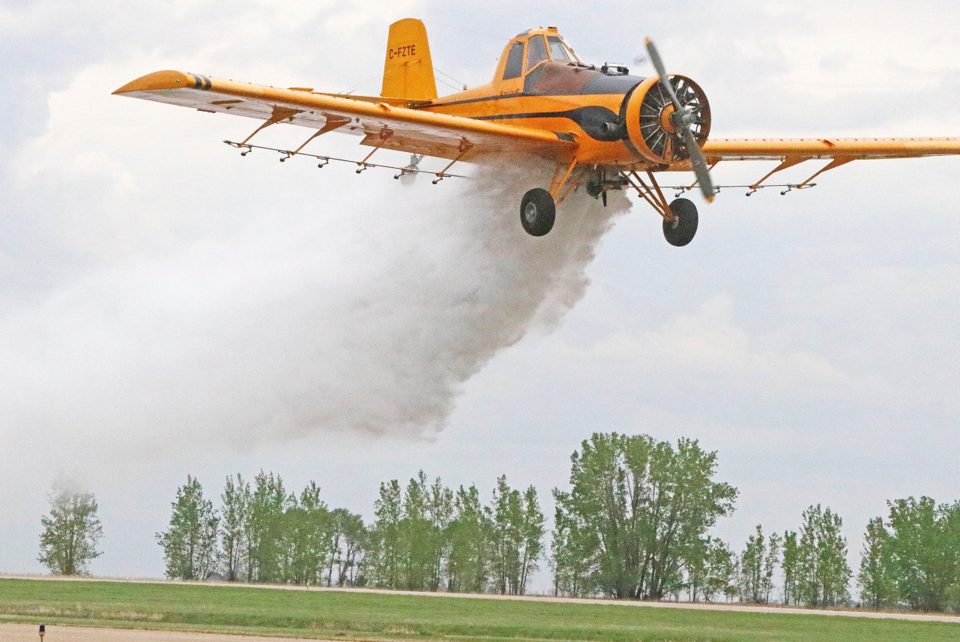Farr Air has been certified as one of seven privately-owned airplane companies that will be part of the province’s new single engine air tanker (SEAT) program, which provides the assistance of small planes to help local fire departments in the case of a large grassland fire.
The program lead for SEAT, Jeff Dickson, talked about how the program will work in a presentation to representatives of several area fire departments, including the Estevan Fire Rescue Service, and the Weyburn Police Service at Farr Air’s hangar at North Weyburn on May 23. The representatives watched a live demonstration.
For the demo, Justin Farr flew a Thrush single-engine aircraft down the runway line behind Farr Air’s hangar, and dropped a mixture of water and foam as directed on the ground by Dickson to show exactly how it would work. Farr flew his plane around once to view the site, and then came down about 30 feet above the ground to drop the water-and-foam mixture.
The seven companies certified by Transport Canada to take part in this program will cover the province from about Prince Albert down to the U.S. border, and are available to be called for assistance by fire departments if they feel they need help to bring a large fire under control.
“This is a quick strike to contain a fire, and let the fire fighters go in and do their job,” said Dickson. “It’s another tool in the toolbox to contain grass fires that can get out of control really quickly.”
He noted that information about the program will go out to every fire department in the province shortly, plus at the provincial level, there is an effort ongoing to add the service to the 911 dispatch, so that a central dispatch can send out a call to one of the airplane companies when the need arises.
He has made presentations like this one at a number of locations already, such as at Yorkton and Moose Jaw, and a two-day training course was held at Prince Albert where Farr Air’s owner Jeff Farr, his son Justin and some of his pilots took their training. Not all of his pilots were able to be trained at that time, but they will be once training is offered again this fall.
Dickson explained that the other companies which have been certified by Transport Canada are based out of Moose Jaw, Yorkton, Nipawin-Tisdale, Battleford, Shaunavon and Kindersley. Farr Air flies out of Weyburn, Estevan, Fillmore and Francis airports, usually for crop dusting applications in the southeast.
With the planes available from the seven companies, they use between 52 to 85 gallons of fuel an hour, using Jet A-1 fuel, and most can carry loads around 500 gallons of water, or a water-foam mix.
“They’re quick, fast and manoeuvrable,” said Dickson of the planes, noting they will swoop in to drop the water at between 30 and 60 feet above the ground, at speeds of between 90 and 120 miles an hour. For the demo, Farr’s plane flew in going into the wind at a speed of around 90 mph.
He also pointed out that it is the fire fighters who put the fires out on the ground, not the aircraft, but the aircraft can help contain a large fire so it’s safer for fire fighters on the ground to go in and finish putting the fires out.
“They can help you work safer and be more effective,” said Dickson. “An aircraft drop without ground support is rarely effective, unless the fire is small.”
Besides helping contain a large fire, the air service can also provide the benefit of a quick aerial view of the entire site where the fire is, and can relay the information to the fire fighters on the ground.
As the planes will mostly be called on for grassland fires, retardant material will not be used by the small planes, said Dickson, as this is mostly used for the forest fires in the northern part of the province. They will use either just water, or water and foam, with foam concentrated enough that one litre can be used in a 500-gallon drop of water.
Work is also underway at the provincial level to establish a specialized radio frequency that can be dedicated for use by the planes in the SEAT program, so radio chatter between firefighters won’t interfere with the radio calls to the pilots.
The program came together quickly, Dickson pointed out, as the proposal for it was still sitting on a desk three months ago.




